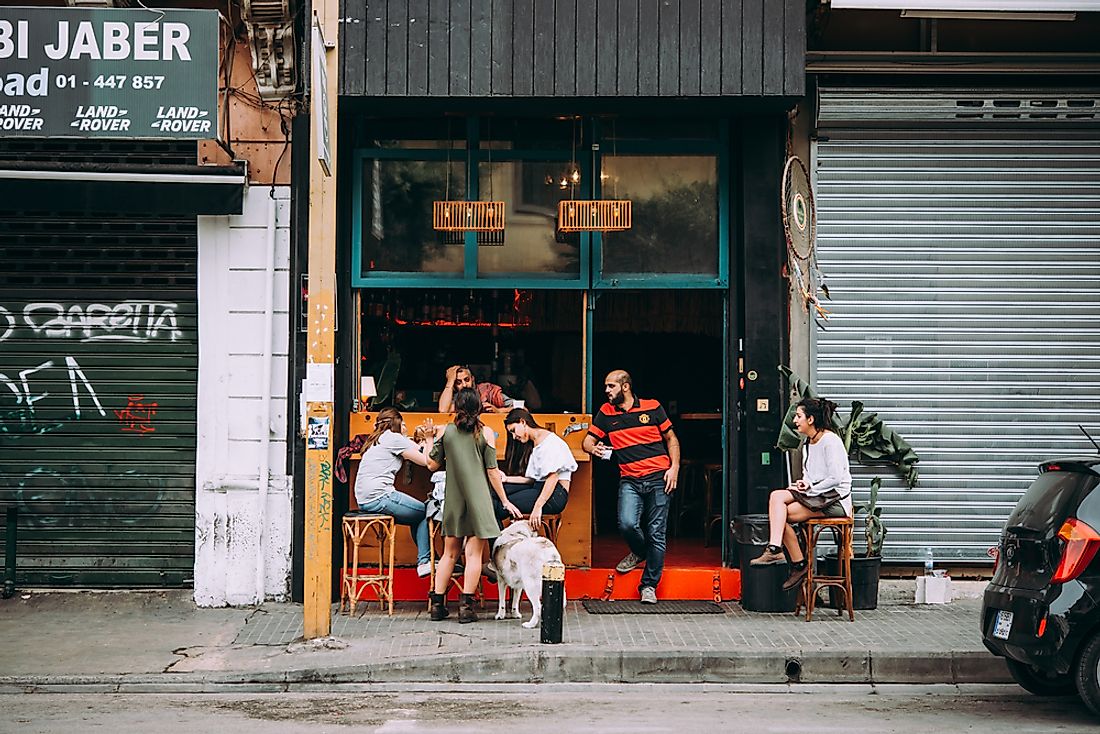What Is The Ethnic Composition Of Lebanon?

Lebanon is a sovereign state in the Western part of Asia and borders Syria, Cyprus, and Israel. The country is found at the crossroads of the hinterland Arabia and Mediterranean Basin, and this explains the countries rich history, which has helped to shape its cultural identity in the region. The country extends to cover an area of 4,036 square miles, making it the smallest sovereign state in the Asian mainland continent.
Lebanese Arabs
The Lebanese Arabs are people living in Lebanon, and the name also is applied to the people who lived in the Anti-Lebanon Mountains and Mount Lebanon before the modern state of Lebanon was created. The Lebanese Arabs account for 95% of the country's population, and they are predominantly the descendants of various ancient people such as the Canaanites (Phoenicians), Greeks (Byzantine), and Arameans (Ancient Syrians). Lebanon has not carried out any official census on the ethnic background of its citizens since 1932 when it was still a French mandate, so it is difficult to get the exact demographic information on the Lebanese Society. A few Arab Lebanese speak the Western Aramaic language while the majority speaks Lebanese Arabic. The Aramaic language is still used as a liturgical language among the Lebanese Maronites, particularly the Maronite church. The Eastern Aramaic language is a type of Syriac language.
Armenians
Lebanese Armenians refer to the citizens of Lebanon who trace their ancestry to the Armenians. The presence of Armenians in Lebanon can be traced back several centuries. According to the estimates of the Minority Rights Group International, 156,000 people in Lebanon trace their ancestry to Armenians, and they account for almost 4% of the total population in the country. Before the Lebanese Civil War, the population of the Armenians was higher, but due to immigration, the population has declined significantly. Before 1975, the capital city of Beirut was the thriving center for the Armenian culture with numerous Media Productions that was exported to the Armenians in the diaspora. The first contact of the Armenians with the Lebanese can be traced to the time when Tigranes the Great captured Phoenicia from the Seleucids and made it part of the Armenian Empire. Later, ancient Lebanon and Armenia were under the Roman Empire, and some of the Roman troops of Armenian descent went to establish Christianity in Armenia. Armenian pilgrims were continually in touch with the Lebanese when they were on their way to Jerusalem, and some would settle in Lebanon. Later during the Ottoman Empire, the presence of Armenians in Lebanon was minimal, but after the Armenian genocide of 1915, there was a large influx of the Armenians to Lebanon.
Jews in Lebanon
There are no statistics on the country showing the population of Lebanese of Jewish ancestry because the latest census in the country was carried out in 1932. The majority of the Lebanese Jews belong to the Sephardi community and lives mostly around the city of Beirut.
Italian Lebanese
The Italian Lebanese refers to the people of Lebanon who trace their history to the Roman period. The region where it is currently the state of Lebanon and Syria became part of the Roman Republic in 64 BC. Before this period and even after, the Romans still exchanged customs, habits, knowledge, and other aspects of life. Between the 12th century and 15 century, the Italian Republic of Genoa had colonies in Tripoli, Beirut, and Byblos. In the more recent past, the Italians immigrated to Lebanon in small numbers, particularly during WWI and WWII when they were escaping the turmoil in Europe. The first Italians to flee and seek refuge in Lebanon were the Italian soldiers from the Italo-Turkish War between 1911 and 1912, although there were few Italians who moved out of Lebanon to France just after independence.
Palestinians
The Palestinians who live in Lebanon include the refugees from Palestine who fled and sought refuge in Lebanon during the 1948 Palestinian War and their subsequent descendants. The Palestinians include the Palestinian militia who lived in Lebanon between the 1970s and 1980s. Another group includes the Palestinians who moved to Lebanon in the recent past. Many Palestinian refugees, including their descendants in Lebanon, have not been naturalized, and therefore their existing status is Palestinian refugees. However, there are Palestinians, particularly the Christians who have managed to obtain Lebanese citizenship through marriage with Lebanese or through other means. According to 2011 estimates, it is believed that the Palestinians in Lebanon were between 260,000 and 400,000. In 2017, the government of Lebanon indicated that there were 174,000 Palestinians in the country.
Syrians in Lebanon
Syrians in Lebanon are mostly migrant workers, and in the recent past, the Syrian refugees have been increasing due to the Syrian Civil War. During the civil war in Lebanon, it led to the 29-year occupation of Lebanon by Syria, which ended in 2005. When the Civil War broke out in Syria, several refugees entered Lebanon starting from 2011. After the end of the Syrian occupation, several Syrians migrated to Lebanon searching for work and better opportunities. As of 2016, the UNHCR estimated that there are more than 1 million Syrian refugees in Lebanon, although the figures are thought to be underestimated because the UNHCR stopped registering Syrian refugees as from May 2015. Other estimates put the figure at 1.5 million Syrians in Lebanon.
Other Ethnic Communities in Lebanon
Lebanon is home to other ethnic groups such as the French Lebanese, Assyrians, Iraqis, Kurds, and Turks, among others.
What Is The Ethnic Composition Of Lebanon?
| Rank | Ethnic group | Percentage of total population |
|---|---|---|
| 1 | Arab | 95% |
| 2 | Armenian | 4% |
| 3 | other | 1% |











